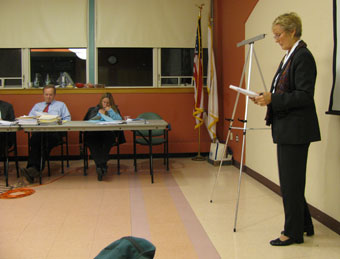Development around Porter Square church dealt blow, may be history

Gwendolen G. Noyes, of Oaktree Development, speaks Thursday to the Cambridge Historical Commission in favor of a condominium project around Porter Square’s St. James’s Episcopal Church. (Photo: Marc Levy)
A 46-condominium building proposed to wrap around Porter Square’s elegant St. James’s Episcopal Church was dealt a setback Thursday by the Cambridge Historical Commission.
The panel voted 4-1 to initiate a landmarking-designation study, in the worst case putting the development on hold for a year to see whether it can go forward without damage to the historic nature of the site. Members said a year’s study was a worst-case scenario — but approval meant having “leverage” over the process.
The commission also had two motions from builders to mull: a demolition petition for the parish house, a 1950s-era structure much plainer than the 120-year-old Richardson Romanesque church; and a request for a certification of appropriateness of construction — an official go-ahead from a board that has already expressed wariness over the project. Each depended on how the commission voted on the landmarking.
The vote came despite an ominous comment from Oaktree Development principal Arthur Klipfel that “I don’t think we can keep it together if we have to keep going through negotiation for another year,” meaning a smaller project would go only on the 2013 Massachusetts Ave. car wash property Oaktree owns, rather than using part of church property.
It would be demanded by Oaktree’s European investors, Klipfel said.
“It’s teetering,” he said of the larger proposal.
The project is a partnership between Cambridge-based Oaktree and the church, which would retain the ground floor of the condominium structure (except for a small retail space) and get a $3 million endowment. Parking would be underground.
The partnership is “creative” and its presentation was “masterful,” said commission chairman William B. King, but “I am a lawyer and I think leverage is important.”
Burden of being landmarked
Some 40 audience members helped fill a room at the Senior Center, across the street from the commission’s usual, smaller space at 831 Massachusetts Ave., and there were several speakers on both sides of the issue. (As well as 20 letters, most in favor of the development, that had to be summarized by Charles Sullivan, executive director of the commission.) Neighbors expressed distress over how the condominiums would change the nature of the area. Proponents such as Rector Holly Lynn Antolini noted the church’s “desperate need, not just urgent need” for money with which it can operate and maintain its facilities.
Problems are arising, namely sagging stained-glass windows poorly contained by aging plastic, and issues such as leaks and general maintenance are reintensifying, Antolini said.
“We cannot be said to have been preserving the garden and parish house,” she said.
A presentation by Ricardo Dumont, a congregant who works on the condominium-church project as a designer with Watertown-based Sasaki Associates, said the height of the proposed building and design of the garden are evolving — and shrinking. The building would be “a simple, modern and sustainable building that does its own thing and doesn’t try to be compete with or be the church,” Dumont said. The word he used repeatedly was that it would be “subservient” to the church, although neighbors worried it would overpower their back yards. (And one neighbor drew laughter and applause by referring to “your institutional, dormitory-looking building.”)
Those concerns aren’t in the purview of the commission, King noted.
In summation, said Oaktree’s Gwendolen G. Noyes, “We’re asking the commission to let us proceed. We don’t want the extra burden of being landmarked.”
Points for debate
The presentation stressed the project’s respect for the historic nature of the church, prompting neighbor John Armstrong to wonder why landmarking was opposed. Antolini said that, because of the proponents’ respect for that historic nature, there was “no need for a landmarking study.” Senior church warden Karen Meredith noted the commission had considered landmarking the site in 2005 and “didn’t see the need,” which others in the audience called a misrepresentation; rather, the commission considered landmarking redundant at the time to a state action.
In this case, the local commission knew its oversight would be keener than that of the Massachusetts Historical Society, which was looking at the church’s landmark status without public input.
Commission members engaged in lengthy debate over the amount of leverage needed, with some suggestion a six-month demolition delay would be adequate to ensure design didn’t deviate from what was being presented Thursday. “It’s an exquisitely designed building,” said commission member Frank Shirley, the sole vote against landmarking. “It does not necessarily hit all the marks … I’m not without concerns if we don’t landmark the whole site.”
Five commission members did not attend. Having not heard the presentation and discussion Thursday, they cannot participate in future votes on the issue.
Update: Later the commission took up the vote on the appropriateness of construction, opting to continue it until a Jan. 7 meeting. Debate made the need to satisfy Oaktree’s investors look slightly more optimistic, with developers, neighbors and commission members seeming to come to swift agreement on revising the parking ramp on Beech Street. A month earlier, neighbors said keeping the ramp off Beech was vital
The sides were urged to keep talking. But disagreement over the height of the condominiums looked to be a sticking point.
A land donor’s 1892 deed restriction on church uses was downplayed by the church and developers, and Armstrong said his raising of it was meant to reflect “general moral and historical issues” more than legal ones.
